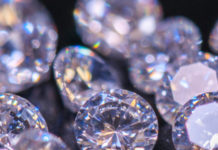
[miningmx.com] — DON’T sell your diamond shares. And definitely don’t
sell them if you happened upon the UK’s irrepressibly enthusiastic Daily Mail
last week.
The UK rag, which is deft in the arts of hyperbole, published an article about a
100km-wide meteorite crater in Russia, created some 35 million years ago and
estimated to hold trillions of carats in diamonds. The newspaper said that the crater
was likely to single-handedly supply the world with diamonds for the next 3,000
years, assuming that human beings aren’t finding new glittery minerals on other
planets by then.
Happily for Anglo American’s De Beers, the crater is not all it’s cracked up to be.
Diamondiferous-bearing craters of this ilk are found in other locations throughout the
world without them actually producing diamonds the world can use as jewellery. A
meteorite smashed into Vredefort once, another in Arkansas in the US.
The problem is that while they contain diamonds, they are generally known to be
“industrial quality’, which means they’re pretty much useless as jewellery. In fact,
there are a lot of industrial diamonds around already and they can also be made in
the laboratory.
The integrity of the diamond crater in Russia is also placed into question by the fact
that Alrosa, Russia’s state-owned diamond miner and marketing firm, is investing
millions of dollars in digging for new diamonds. The feeling is it wouldn’t be doing this
if the material was available so freely on its doorstep.
“Meteorites are also associated with some of the diamond deposits in Brazil,’ says
Des Kilalea, a diamond analyst for Canadian bank RBC Capital Markets. “Conclusion:
interesting story but not a reason to sell your diamond shares,’ he says.
– Finweek










